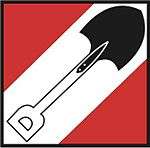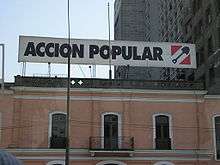Popular Action (Peru)
Popular Action Acción Popular | |
|---|---|
 | |
| President | Mesías Guevara Amasifuén |
| General Secretary | Rafael Vásquez Neyra |
| Founder | Fernando Belaúnde Terry |
| Founded | July 7, 1956 |
| Headquarters | Lima |
| Ideology |
Reformism[1] Nationalism[2] |
| Political position |
Centre[3][4] to Centre-right[5][6][7] |
| International affiliation | None |
| Congress |
5 / 130 |
| Website | |
|
accionpopular | |

The Popular Action (Spanish: Acción Popular, AP) is a political party in Peru.
History
Fernando Belaúnde founded Popular Action (Acción Popular) in 1956 as a reformist alternative to the status quo conservative forces and the populist American Popular Revolutionary Alliance party.
Although Belaúnde's message was not all that different from APRA's, his tactics were more inclusive and less confrontational. He was able to appeal to some of the same political base as APRA, primarily the middle class, but also to a wider base of professionals and white-collar workers. It also advocated scientific advancement and technocracy, a policy set that it took from the Progressive Social Movement, a splinter party which it eventually absorbed.[8] The AP had significant electoral success, attaining the presidency in 1963 and 1980, but the party was more of an electoral machine for the persona of Belaúnde than an institutionalized organization. The AP was initially reckoned as a center-left party. However, by the 1980s, Peru's political spectrum had shifted sharply leftward, and the AP found itself on the center-right.
After AP's second administration, in 1985, the party only got 6.4 percent of the vote. In 1990 AP participated in the elections as a part of the Democratic Front, a center-right coalition headed by Mario Vargas Llosa.
AP member Valentín Paniagua would become President of Congress in October 2000 and, after the demise of the Fujimori administration, became the interim President of the Republic, holding office from November 2000 to July 2001.
At the 8 April 2001 election, the party won 4.2% of the popular vote and three of 120 seats in Congress.
For the 2006 national election, the party joined forces with Somos Perú and Coordinadora Nacional de Independientes to form the Frente de Centro coalition. Paniagua was the presidential candidate, while the vice-presidential candidates belonged to AP's allies. The Center Front ended in the fifth place in the national election, with 5.6% of the popular vote.
For the 2011 national election, the party joined forces with Somos Perú and Perú Possible to form the Peru Possible Alliance. The presidential candidate was former Peru's President and leader of Perú Possible, Alejandro Toledo. The alliance ended in the fourth place in the national election, with 15.6% of the popular vote.
For the 2016 national election, the party ran alone for the first time since 2000, when Congressman Víctor Andrés García Belaúnde ran against the sitting president Alberto Fujimori, and it was the first time since 2006 that Popular Action participated with a party member as a presidential candidate, when former President Valentín Paniagua ran for office. The presidential candidate was Alfredo Barnechea, journalist and political analyst, who won the party's primaries with 52% of the votes, defeating Mesías Guevara (40%), currently the party's president for the 2014-2018 term, the lawyer Beatríz Mejía (6%) and former Deputy Alejandro Montoya (2%). Popular Action ended in the fourth place in the national election, with 6.97% of the popular vote. This has been the best result for Popular Action since 1985.
For the 2016-2021 term, AP will have five of 130 congressmen representing the party.
Presidents of Peru from Popular Action

Presidential candidates of AP
- 1956 - Fernando Belaúnde Terry
- 1962 - Fernando Belaúnde Terry
- 1963 - Fernando Belaúnde Terry
- 1980 - Fernando Belaúnde Terry
- 1985 - Javier Alva Orlandini
- 1990 - Mario Vargas Llosa (Coalition with FREDEMO)
- 1995 - Raúl Diez Canseco
- 2000 - Víctor Andrés García Belaúnde
- 2001 - No Candidate
- 2006 - Valentín Paniagua (Coalition with Center Front)
- 2011 - Alejandro Toledo (Coalition with Possible Peru)
- 2016 - Alfredo Barnechea
References
- ↑ Geddes, Barbara (2003), Paradigms and Sand Castles: Theory Building and Research Design in Comparative Politics, University of Michigan Press, p. 283
- ↑ Roncagliolo, Rafael (2011). Of Parties and Party Systems. Fractured Politics: Peruvian Democracy Past and Present. Institute for the Study of the Americas, University of London. p. 71.
- ↑ Levitsky, Steven; Cameron, Maxwell A. (2009), "Democracy Without Parties? Political Parties and Regime Changes in Fujimori's Peru", Latin American Democratic Transformations: Institutions, Actors, Processes, John Wiley & Sons, p. 342
- ↑ Seawright, Jason (2012), Party-System Collapse: The Roots of Crisis in Peru and Venezuela, Stanford University Press, p. 166
- ↑ Carrión, Julio F. (2009), "The Persistent Attraction of Populism in the Andes", Latin American Democracy: Emerging Reality or Endangered Species?, Routledge, p. 238
- ↑ Middlebrook, Kevin J. (2000), "Introduction: Conservative Parties, Elite Representation and Democracy in Latin America", Conservative Parties, the Right, and Democracy in Latin America, Johns Hopkins University Press, p. 29
- ↑ Patrón Galindo, Pedro (2010), "Political marketing in a weak democracy? The Peruvian case", Global Political Marketing, Routledge, p. 202
- ↑ Hugo Neira, "Peru" in JP Bernard et al., Guide to the Political Parties of South America, Harmondsworth: Penguin, 1973, p. 443